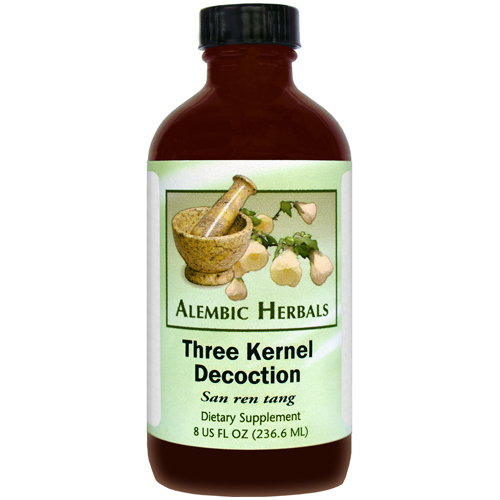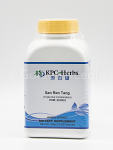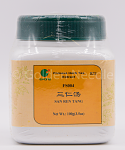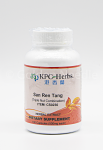| Description |
"This formula is ascribed to early stages of damp warmth disease, with a heavy component of damp, and mild heat. With simultaneous disease in the wei qi/defense qi. The lung governs qi, associated with defense qi. When defense qi is obstructed by damp evil, it produce aversion to cold. Dampness stagnating in the defense/exterior causes the qing yang/clear yang to be obstructed, causing a band-like headache. This is what Ye Tian-shi means when he says that damp and warmth steam, depress, and cloud above (in the upper burner). The clear orifices (sense organs) become congested, and turbid evil damages the clear (Wai gan wen re lun/Ye Tian-shi). Because there is heat located in the dampness evil, being a yang evil it forces the dampness to move, therefore although there is heat effusion, it is generalized and unresolved. The dampness and heat steam together. Damp is a yin evil, its nature is sticky and stagnating. Dampness forces the heat to become latent, and it obstructs the three burners. It becomes lodged in the qi fe/qi aspect, which causes the heat effusion to become severe in the afternoon. Dampness is heavy in nature, so when it becomes lodged in the fleshy exterior, it causes generalized heaviness and fatigued limbs. Damp turbidity obstructs the center burner, clear fluids fail to bear upward, so they brew below and cause short voiding of reddish urine. The white greasy tongue fur and wiry thin and soggy pulse are both signs of dampness and heat." - Z'ev Rosenberg: Clinical Guide for Practitioners* "In modified Three Kernel Decoction, the three sovereign medicinals are Yi yi ren (Job's tears seed), for disinhibiting dampness from the lower burner, Bai dou kou (Chinese cardamom fruit) for clearing dampness from the middle burner and aromatically awakening the spleen, and Xing ren (Apricot seed) for disinhibiting dampness from the upper burner, while regulating lung qi, By regulating lung qi, circulating qi restores normal water metabolism and helps alleviate systemic dampness. Hou po (Magnolia bark) is warm and aromatic, regulating digestion, relieving distention and normalizing bowel movements. Jiang ban xia (Ginger-cured pinellia) descends counterflow qi and turbid yin, relieves distention, and resolves phlegm. Tong cao (Tetrapanax/Rice paper plant pith) disinhibits urination and clears amp heat, and Dan zhu ye (Lopatherum/bamboo leaf and stem) clears heat from the upper burner, eliminating vexation, and disinhibits damp heat through urination. In this version of the prescription, we have removed the Hua shi (Talcum) from the original prescription and added Yin chen hao (Capillaris), bitter, cool and aromatic, to clear damp heat from the liver spleen, stomach and gallbladder. This medicinals also help broaden the scope of this formula to treat patients with jaundice or any damp warmth disorder with gallbladder/liver involvement. We have also added Qing hao (Sweet wormwood) to outthrust evil heat from the qi fen/qi aspect to the exterior and reduce heat effusion. both herbs enter the shao yang channel, to this formula can also treat malaria-like disorders with damp heat, with alternating heat effusion and chill. Finally, we have added Huo xiang (Chinese giant hyssop), which is aromatic, acrid and slightly warm, to release the exterior, resolve dampness, and benefit the middle burner. - Rosenberg: Clinical Guide*
|






